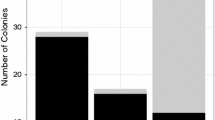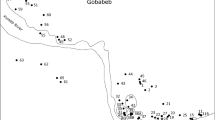Abstract
In many polygynous ant species, established colonies adopt new queens secondarily. Conflicts over queen adoption might arise between queens and workers of established colonies and the newly mated females seeking adoption into nests. Colony members are predicted to base adoption decisions on their relatednesses to other participants, on competition between queens for colony resources, and on the effects that adopted queens have on colony survivorship and productivity. To provide a better understanding of queen-adoption dynamics in a facultatively polygynous ant, colonies of Myrmica tahoensis were observed in the field for 4 consecutive years and analyzed genetically using highly polymorphic microsatellite DNA markers. The extreme rarity of newly founded colonies suggests that most newly mated queens that succeed do so by entering established nests. Queens are closely related on average (r¯ = 0.58), although a sizable minority of queen pairs (29%) are not close relatives. An experiment involving transfers of queens among nests showed that queens are often accepted by workers to which they are completely unrelated. Average queen numbers estimated from nest excavations (harmonic mean = 1.4) are broadly similar to effective queen numbers inferred from the genetic relatedness of colony members, suggesting that reproductive skew is low in this species. Queens appear to have reproductive lifespans of only 1 or 2 years. As a result, queens transmit a substantial fraction of their genes posthumously (through the reproduction of related nestmates), in comparison to direct and indirect reproduction while they are alive. Thus queens and other colony members should often accept new queens when doing so will increase colony survivorship, in some cases even when the adopted queens are not close relatives.
Similar content being viewed by others
Author information
Authors and Affiliations
Additional information
Received: 20 February 1996/Accepted after revision: 25 May 1996
Rights and permissions
About this article
Cite this article
Evans, J. Queen longevity, queen adoption, and posthumous indirect fitness in the facultatively polygynous ant Myrmica tahoensis . Behav Ecol Sociobiol 39, 275–284 (1996). https://doi.org/10.1007/s002650050290
Issue Date:
DOI: https://doi.org/10.1007/s002650050290




